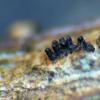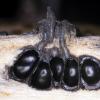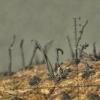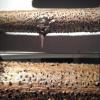
26-12-2025 21:19
Arnold BüschlenPithyella chalaudii Priou. Ist als Bryoparasit in

21-12-2025 09:32
Hello.A tiny ascomycete found embedded in wood in

18-12-2025 21:17
Pol DebaenstThe identification took me to Byssonectria deformi

24-12-2025 17:08
Hulda Caroline HolteHello, I have found this propoloid ascomycete on

21-12-2025 21:32
Pol DebaenstHello, Garden, Burgweg 19, Veurne, BelgiumOn 10/1
Diaporthe on Berberis
Martin Bemmann,
19-11-2009 22:19
 Dear all,
Dear all,I found this Pyreno on a still attached but dead twig on a Berberis shrub.
Macroscopicaly it may belong to the Diaporthales (to me as an quite unexperienced amateur) .
I thought: easy job (by means of microscopy), but it turned out to be as crucial as as an Orbilia. Everything was so tiny. And the worst thing was, that my microscope crashed during examination (spareparts will come at the weekend..)
But I can't wait to ask you by now ;-)
Spores I have seen are alantoid and 4,3-5,6X1,1-1,6 µm.
One single ascus I could check was IKI + and 46X3,5 µm. Shaped pyriforme with a long thin "tail".
For now I just can show a macro-photograph.
I'm sure, some of you have allready an idea.. ;-)
All the best,
Martin
Jacques Fournier,
19-11-2009 22:55

Re:Diaporthe on Berberis
Hi Martin,
I suggest Eutypella scoparia. Try a vertical section of the stroma, the ostiolar necks should be convergent, like on the attached photo, maybe with some olivaceous powdery tissue around.
It is a very common and very tricky member of Diatrypaceae.
Good evening,
Jacques
I suggest Eutypella scoparia. Try a vertical section of the stroma, the ostiolar necks should be convergent, like on the attached photo, maybe with some olivaceous powdery tissue around.
It is a very common and very tricky member of Diatrypaceae.
Good evening,
Jacques
Alain GARDIENNET,
20-11-2009 08:29
Re:Diaporthe on Berberis
Dear Martin,
I'm agree with Jacques, of course. Macroscopicaly, some Diatrypaceae (genus Eutypella) look like some Diaporthaceae (genus Diaporthe), but when we see them with more attention, we can find differences. Of course, the microscopy gives the own difference.
On Berberis, the species of the genus Diaporthe is Diaporthe detrusa. You can find it on http://www.ascofrance.fr/index.php?r=bdd&page=fiche&id=2306.
I note that you have found Eutypella scoparia on Berberis (vulgaris ?). Perhaps, I will meet it on this host too.
Alain
I'm agree with Jacques, of course. Macroscopicaly, some Diatrypaceae (genus Eutypella) look like some Diaporthaceae (genus Diaporthe), but when we see them with more attention, we can find differences. Of course, the microscopy gives the own difference.
On Berberis, the species of the genus Diaporthe is Diaporthe detrusa. You can find it on http://www.ascofrance.fr/index.php?r=bdd&page=fiche&id=2306.
I note that you have found Eutypella scoparia on Berberis (vulgaris ?). Perhaps, I will meet it on this host too.
Alain
Martin Bemmann,
20-11-2009 09:01

Re:Diaporthe on Berberis
Dear Jaques and Alain,
Thank you for turning my head to this common species! Though I found it only once during my short mycological career (on Hibiscus). These specimen had much longer necks. Maybe that's why I didn't remember...
I can't tell you what Berberis it was exactly. It was a cultured one in a garden.
Have a nice day!
Martin
Thank you for turning my head to this common species! Though I found it only once during my short mycological career (on Hibiscus). These specimen had much longer necks. Maybe that's why I didn't remember...
I can't tell you what Berberis it was exactly. It was a cultured one in a garden.
Have a nice day!
Martin
Alain GARDIENNET,
20-11-2009 10:38
Re:Diaporthe on Berberis
Yes, the length of scoparia's neck is very variable. The difference between two recolts can be spectacular.
Bonne journée à toi,
Alain
Bonne journée à toi,
Alain
Martin Bemmann,
20-11-2009 21:52
Jean-Pierre Lafont,
21-11-2009 00:18
Re:Diaporthe on Berberis
Hello Martin
The necks of Eutypella scoparia are not so variable, but In your last figure, they are probably surrounded by synnema of its Harpographium anamorph.
Good night!
Jean-Pierre
The necks of Eutypella scoparia are not so variable, but In your last figure, they are probably surrounded by synnema of its Harpographium anamorph.
Good night!
Jean-Pierre
Martin Bemmann,
21-11-2009 00:38

Re:Diaporthe on Berberis
Hello Jean-Pierre,
do you mean these long necks are from Harpographium? The only refence I have at hands for this genus is Barnett/Hunter and there (though those drawings are poor, at least in my copy) the fruit bodies feature a tufted structure at the top which I can't determine at my collection.
Bonne nuit,
Martin
do you mean these long necks are from Harpographium? The only refence I have at hands for this genus is Barnett/Hunter and there (though those drawings are poor, at least in my copy) the fruit bodies feature a tufted structure at the top which I can't determine at my collection.
Bonne nuit,
Martin
Alain GARDIENNET,
21-11-2009 07:32
Re:Diaporthe on Berberis
Salut jean-Pierre,
J'insiste sur le fait que les ostioles (=necks, excuse me Martin, it's easier for me to use my language) sont très variables. Je l'affirme de par mes observations : très grands,cylindriques, dépassant parfois les 2 mm dans certaines récoltes, en général sur Robinia mais aussi parfois très petits (comme sur la photo de Jacques) ce qui rend sa détermination moins rapide au premier visu, les ostioles étant fendus parfois sur toute leur longueur rappelant d'autres espèces du genre Eutypella. Je l'affirme aussi en lisant Rappaz qui est quand même ce qui se fait de mieux jusqu'à aujourd'hui sur ce sujet.
Mais converser sur ces ostioles est intéressant et me fait venir l'idée de récolter un maximum de diverses récoltes de E. scoparia. Je ne sais pas si qqun a déjà essayé avec nos moyens modernes de voir si derrière ces observations pouvaient se cacher deux espèces, mais si ce n'a jamais été fait, ça me semblerait être une bonne idée de le faire. S'il n'y a qu'une espèce, ça ne me gêne pas et il faudra continuer à dire dans les ouvrages que la longueur de l'ostiole peut être très variable.
Je ne connaissais pas l'existence de son anamorphe et donc ne rajouterai rien à tes propos sur ce sujet.
Je suis content de parler d'une espèce que j'aime bien avec des gens que j'apprécie.
Bonne journée,
Alain
J'insiste sur le fait que les ostioles (=necks, excuse me Martin, it's easier for me to use my language) sont très variables. Je l'affirme de par mes observations : très grands,cylindriques, dépassant parfois les 2 mm dans certaines récoltes, en général sur Robinia mais aussi parfois très petits (comme sur la photo de Jacques) ce qui rend sa détermination moins rapide au premier visu, les ostioles étant fendus parfois sur toute leur longueur rappelant d'autres espèces du genre Eutypella. Je l'affirme aussi en lisant Rappaz qui est quand même ce qui se fait de mieux jusqu'à aujourd'hui sur ce sujet.
Mais converser sur ces ostioles est intéressant et me fait venir l'idée de récolter un maximum de diverses récoltes de E. scoparia. Je ne sais pas si qqun a déjà essayé avec nos moyens modernes de voir si derrière ces observations pouvaient se cacher deux espèces, mais si ce n'a jamais été fait, ça me semblerait être une bonne idée de le faire. S'il n'y a qu'une espèce, ça ne me gêne pas et il faudra continuer à dire dans les ouvrages que la longueur de l'ostiole peut être très variable.
Je ne connaissais pas l'existence de son anamorphe et donc ne rajouterai rien à tes propos sur ce sujet.
Je suis content de parler d'une espèce que j'aime bien avec des gens que j'apprécie.
Bonne journée,
Alain
Jean-Pierre Lafont,
21-11-2009 23:39
Re:Diaporthe on Berberis
Bonsoir Alain et Martin, et merci Alain pour ton amicale conclusion, c'est partagé!
Maybe I was too fast in suggestig that the long and slim stalks could be synnema of Harpographium. When present, they are rarely over 1 x 0.2 mm, probably shorter and more slender than what we see on Martin's photograph (what is the scale?), and they appear to be connected to the stroma and not to the underlying perithecia.
I agree that ostiolar necks are not of uniform size but in my (limited) experience, most collections are either long- or short-necked. This could actually suggest the existence of different species as hypothesized by Alain. Rappaz considers only one species with a wide host-range, but reports differences in the anamorph cultures obtained from different collections.
Jacques probably knows whether further work has been done on this question.
The best figure and description I know for Harpographium fasciculatum is in Ellis, 1971, "Dematiaceous Hyphomycetes", pp 562-563, better than those of Harper/Hunter.
Amitiés à tous les deux
Jean-Pierre
Maybe I was too fast in suggestig that the long and slim stalks could be synnema of Harpographium. When present, they are rarely over 1 x 0.2 mm, probably shorter and more slender than what we see on Martin's photograph (what is the scale?), and they appear to be connected to the stroma and not to the underlying perithecia.
I agree that ostiolar necks are not of uniform size but in my (limited) experience, most collections are either long- or short-necked. This could actually suggest the existence of different species as hypothesized by Alain. Rappaz considers only one species with a wide host-range, but reports differences in the anamorph cultures obtained from different collections.
Jacques probably knows whether further work has been done on this question.
The best figure and description I know for Harpographium fasciculatum is in Ellis, 1971, "Dematiaceous Hyphomycetes", pp 562-563, better than those of Harper/Hunter.
Amitiés à tous les deux
Jean-Pierre
Martin Bemmann,
22-11-2009 01:56

Re:Diaporthe on Berberis
Hi Jean-Pierre,
Yes , it's a matter of scale probably. I can't tell you the size of my Hibiscus-specimen, because it was shot through the lens of my Bino, which is not calibratable (it is a zoom model).
But I think I understood what you ment and I tried to find something today in this direction. On some dead twigs of the Hibiscus in my garden (this is not the Hibiscus of the "scoparia" above, that one is from the garden of my office...) I found a black felty layer of an anamorphous fungus. These conidiophores resemble a bit to the "necks" of my "Eutypella", but they are much thinner then those. Comes this close to that what you meant? (Ellis is not available to me, Helas!)
Good Night,
Martin
Yes , it's a matter of scale probably. I can't tell you the size of my Hibiscus-specimen, because it was shot through the lens of my Bino, which is not calibratable (it is a zoom model).
But I think I understood what you ment and I tried to find something today in this direction. On some dead twigs of the Hibiscus in my garden (this is not the Hibiscus of the "scoparia" above, that one is from the garden of my office...) I found a black felty layer of an anamorphous fungus. These conidiophores resemble a bit to the "necks" of my "Eutypella", but they are much thinner then those. Comes this close to that what you meant? (Ellis is not available to me, Helas!)
Good Night,
Martin
Jacques Fournier,
22-11-2009 08:31

Re:Diaporthe on Berberis
Hi all,
we are dealing with two different things. The length of the ostiolar necks is obviously linked with the external conditions: it can be easily observed on the bark a log of Robinia that is half buried in the soil and most often invaded by E. scoparia. While the necks emerging from the buried part are very long, up to 2mm long in my experience, they appear much shorter, at times hardly protruding in upper, sun-exposed part of the log. The stromatal morphology is likewise very variable depending on the degree of moisture, but asci and ascospores are typical enough to allow a safe identification.
The question about the putative anamorph being Harpographium is still unclear, but I am inclined to consider Hatpographium merely as a parasite frequently occurring on E. scoparia. Harpographium is a synnematous hyphomycete, while most of known anamorphs of Diatrypaceae are coelomycetous, occuring in pycnidia and referred to the genus Libertella. Rappaz (1987) described such pycnidial formation in cultures of E. scoparia, but curiously the shape and dimensions of conidia are similar to those of Harpographium! This problem would maybe deserve more field work and comparison of DNA sequences to be solved.
Have a nice Sunday!
Jacques
we are dealing with two different things. The length of the ostiolar necks is obviously linked with the external conditions: it can be easily observed on the bark a log of Robinia that is half buried in the soil and most often invaded by E. scoparia. While the necks emerging from the buried part are very long, up to 2mm long in my experience, they appear much shorter, at times hardly protruding in upper, sun-exposed part of the log. The stromatal morphology is likewise very variable depending on the degree of moisture, but asci and ascospores are typical enough to allow a safe identification.
The question about the putative anamorph being Harpographium is still unclear, but I am inclined to consider Hatpographium merely as a parasite frequently occurring on E. scoparia. Harpographium is a synnematous hyphomycete, while most of known anamorphs of Diatrypaceae are coelomycetous, occuring in pycnidia and referred to the genus Libertella. Rappaz (1987) described such pycnidial formation in cultures of E. scoparia, but curiously the shape and dimensions of conidia are similar to those of Harpographium! This problem would maybe deserve more field work and comparison of DNA sequences to be solved.
Have a nice Sunday!
Jacques
Martin Bemmann,
22-11-2009 11:03

Re:Diaporthe on Berberis
Thank you Jaques for your explanations!
Bonne journée,
Martin
Bonne journée,
Martin
Jean-Pierre Lafont,
22-11-2009 17:10
Re:Diaporthe on Berberis
Bonjour Jacques et Martin
Merci Jacques, je comprends pourquoi j'ai trouvé E. scoparia avec des becs plutôt longs ou plutôt courts selon les récoltes, mais pas avec un mélange de becs longs et courts sur le même exemplaire.
Ce serait très logique aussi que Harpographium soit un parasite ou un commensal plutôt qu'un anamorphe, et ça pourrait expliquer pourquoi on ne le trouve pas si souvent: il aurait sa propre distribution au sein de celle de l'hôte scoparia.
OK Martin, your last photograph shows very slim and somewhat forked structures which could likely be synnema of "Harpographium fasciculatum". This is really close to what I meant.
Bon dimanche à vous deux
Jean-Pierre
Merci Jacques, je comprends pourquoi j'ai trouvé E. scoparia avec des becs plutôt longs ou plutôt courts selon les récoltes, mais pas avec un mélange de becs longs et courts sur le même exemplaire.
Ce serait très logique aussi que Harpographium soit un parasite ou un commensal plutôt qu'un anamorphe, et ça pourrait expliquer pourquoi on ne le trouve pas si souvent: il aurait sa propre distribution au sein de celle de l'hôte scoparia.
OK Martin, your last photograph shows very slim and somewhat forked structures which could likely be synnema of "Harpographium fasciculatum". This is really close to what I meant.
Bon dimanche à vous deux
Jean-Pierre
Alain GARDIENNET,
22-11-2009 20:28
Re:Diaporthe on Berberis
Le tandem Jacques-Martin, un dimanche, ça ne s'invente pas ... ;)
Sous vos applaudissements...
(Martin : it refers to french TV)
Alain
Sous vos applaudissements...
(Martin : it refers to french TV)
Alain
Jean-Pierre Lafont,
22-11-2009 20:44
Re:Diaporthe on Berberis
Toujours en forme à toute heure, Alain!!!
Bonne nuit, attention demain c'est lundi!
Amitiés
JP
Bonne nuit, attention demain c'est lundi!
Amitiés
JP
Martin Bemmann,
22-11-2009 20:54

Re:Diaporthe on Berberis
Hi Alain et les autres,
I searched today for Eutypella under a Robinia close to my house and found a twig full of those after some minutes.
The length of the necks on one and the same twig, the ascocarps beeing only centimetres in distance, was, depending on beeing on top or looking downwards, between merely emerging through the bark up to beeing erected over 2mm.
Attached a picture of the latter case.
Cheers,
Martin
I searched today for Eutypella under a Robinia close to my house and found a twig full of those after some minutes.
The length of the necks on one and the same twig, the ascocarps beeing only centimetres in distance, was, depending on beeing on top or looking downwards, between merely emerging through the bark up to beeing erected over 2mm.
Attached a picture of the latter case.
Cheers,
Martin
Jacques Fournier,
22-11-2009 21:26

Re:Diaporthe on Berberis
Martin,
this is a very nice story!!
Good night,
jacques
this is a very nice story!!
Good night,
jacques
Alain GARDIENNET,
22-11-2009 21:51
Re:Diaporthe on Berberis
Yes, it is,
and as I like stories just before dreaming, Martin, have you found other pyrenomycetes on Robinia ? (Diaporthe oncostoma, Aglaospora profusa, or Nectriaceae for example...) It could be the start of a new story, a second season. In France for the children (girls) we have the book series of Martine : Martine à la plage, Martine fait du vélo ... It could be with you : Martin and Berberis, Martin and Robinia ....
Sorry ! ;)
Alain
and as I like stories just before dreaming, Martin, have you found other pyrenomycetes on Robinia ? (Diaporthe oncostoma, Aglaospora profusa, or Nectriaceae for example...) It could be the start of a new story, a second season. In France for the children (girls) we have the book series of Martine : Martine à la plage, Martine fait du vélo ... It could be with you : Martin and Berberis, Martin and Robinia ....
Sorry ! ;)
Alain
Martin Bemmann,
22-11-2009 22:03
Martin Bemmann,
22-11-2009 22:22

Re:Diaporthe on Berberis
Hi Alain again,
I understand what you mean. But with an "si tacuisses" attitude nobody will learn anything.
In case I am bugging you, just tell me straight!
With best regards,
Martin of Robinia ;-)
I understand what you mean. But with an "si tacuisses" attitude nobody will learn anything.
In case I am bugging you, just tell me straight!
With best regards,
Martin of Robinia ;-)
Alain GARDIENNET,
22-11-2009 22:42
Re:Diaporthe on Berberis
Hi Martin,
You have perhaps not understood my (not good) humour, I only want to tell you that I was appraising this story around this Eutypella, like Jacques. Your researching was interessant for a better comprehension of this species. I thank you. And I ask you to talk about other recolts on this forum. It's in my nature to always do serious things and bring humour over it. But my language, as my humour is not always very good, I know. Excuse me.
It's not easy to do it between germanist and french in english.
Let's place to mycology now,
Good night,
I hope to read you later,
Alain
You have perhaps not understood my (not good) humour, I only want to tell you that I was appraising this story around this Eutypella, like Jacques. Your researching was interessant for a better comprehension of this species. I thank you. And I ask you to talk about other recolts on this forum. It's in my nature to always do serious things and bring humour over it. But my language, as my humour is not always very good, I know. Excuse me.
It's not easy to do it between germanist and french in english.
Let's place to mycology now,
Good night,
I hope to read you later,
Alain
Martin Bemmann,
22-11-2009 23:03

Re:Diaporthe on Berberis
Thanks Alain,
I didn't get you right, obviously. I should have trusted more in our sense of humour we have in common as asco-weirdos...
Maybe I should more observe French TV? (I don't look to the German one either...)
I am looking forward to read your contributions and to discuss mine.
All the best and
bonne nuit
Martin
I didn't get you right, obviously. I should have trusted more in our sense of humour we have in common as asco-weirdos...
Maybe I should more observe French TV? (I don't look to the German one either...)
I am looking forward to read your contributions and to discuss mine.
All the best and
bonne nuit
Martin






